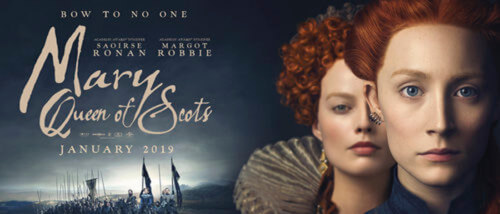Mary Queen Of Scots (2019) Review
Mary Queen Of Scots (2019)
Director: Josie Rourke
Screenwriter: Beau Willimon
Cast: Saoirse Ronan, Margot Robbie, Jack Lowden, Joe Alwyn, David Tennant, Guy Pearce.
Plot: In the turmoil of 16th century Britain, two Queens are caught in an inevitable struggle to keep their throne and their lives.
The story of Josie Rourke’s Mary Queen of Scots focuses on Mary Stewart’s life, Elizabeth I’s cousin and the Stuart pretender to the English throne. A flash forward of her imminent execution, shown at the beginning of the film, immediately produces a very emotional impact on the audience, transporting them into the midst of 16th century Scotland and the political upheaval the country was going through. Through the use of flashback, one of the foremost functions of storytelling on offer in the film, a meaningful cross-cut shows us Mary with her head deep in the sand off the Scottish coast and thus to the beginning of her journey to her eventual demise, thus creating a ring composition of sorts that effectively closes the circle, and metaphorically Mary’s life.
After the death of her husband, Francis II of France, Mary returns to Scotland, her native country, to finally rule it as Queen. The story focuses not only on Mary’s struggle to keep her crown and avoid a civil war between Catholics and Protestants in Scotland, but also on her relationship with England’s Queen Elizabeth, on whose throne Mary lays a claim. Mary’s portrayal as a strong leader, trying to rule in a rebellious country filled with traitors and political plots – one led by no other than her stepbrother James – attempting to overthrow her, is particularly significant, as this mirrors Elizabeth’s own role as a powerful woman at a time when women were not expected to assert themselves. The way the film successfully shows the perspectives of both Queens and their destinies as they are trying to survive in a world ruled by men is more relevant today than seemingly ever before and is presented with such a glorious mix of brutality and delicacy. The world of the time is indeed shown as a dark, shallow and most importantly an extremely violent place – plotting and intrigues at court were rife, and anyone having different opinions could risk their lives, especially if they were caught up in a power struggle.
These aspects were most striking in how interesting they were and how vital they were to not only providing an insight into 16th century British society but also the the violent nature of man. At times, the script perhaps leant too heavily on these evils when it could have concentrated more firmly on Mary’s inner self and struggles, the climactic moments of the picture lacking the impact they could have had with a further exploration of her personal struggle throughout her historic journey.
Quite importantly, the film features many historical inaccuracies, some of which the film itself addresses in title cards at the start and end of the film, but more than that is the film’s divisive presentation of potentially disturbing sexual content and excessive gore, leaving one to wonder if implying rather than showing may have produced a more tasteful result.
The atmosphere in general is gloomy, bleak and very dark, with barely any light during the whole film, and rightfully so given the events on offer. Nevertheless, it may have been worthwhile to include more of the Scottish landscape that the Queen herself referenced as the character to whom she served (as opposed to her people) and was therefore of the utmost importance as regards her own motivations, both personally and professionally. What’s more is that it was fundamental to the characterisations of the two central characters and their differences to one another, the wild moors of the Scottish highlands contrasting with the well farmed, luxurious palaces of southern England. As there were very few important moments of dialogue and a number of historical inaccuracies, as well as arguably unnecessary gore and sexual content, the performances delivered by the film’s cast, and specifically the portrayal of Mary and Elizabeth’s relationship, became the crux of Mary Queen of Scot’s attraction to any given audience; a relationship developed by the presentation of similarities and differences rather than one-to-one conversation but expertly crafted nonetheless.
Mary and Elizabeth’s relationship gave the audience a chance to see another side of their characters and of how they could have felt under the difficult circumstances they were in. This almost tender side of their relationship, which at times truly felt like they were sisters, was never shown before.
On that note, the most meaningful scene in Mary Queen of Scots is the confrontation between the two Queens that was so heavily featured in the promotional material. Along the way, Mary and Elizabeth are established as joint leads, but it is Margot Robbie’s portrayal of a troubled and almost weak Queen that truly takes the breath away; her every decision influenced by her council (made up, importantly, of men). After all, more than a war between sisters, this film is about a war between the loving nature of family and womanhood versus that of the destructive and animalistic nature of manhood.
In the end the film, the film wasn’t quite the blow away hit that many had expected it to be (and the expectations were admittedly very high given the story’s historical significance and the cast attached to the project), but given the film’s well developed themes and high quality performances, Mary Queen of Scots is a…
17/24
[DISPLAY_ULTIMATE_SOCIAL_ICONS]


